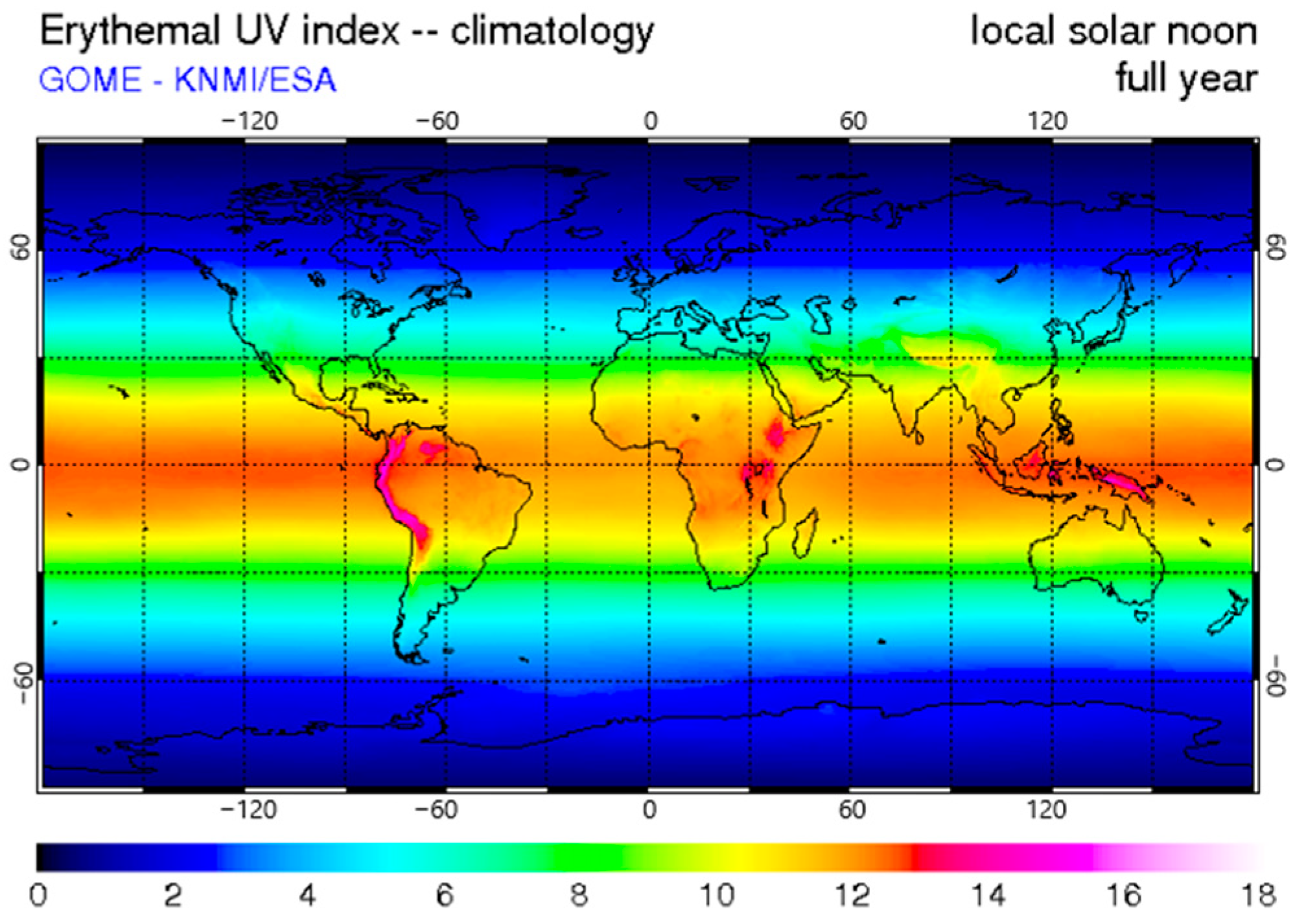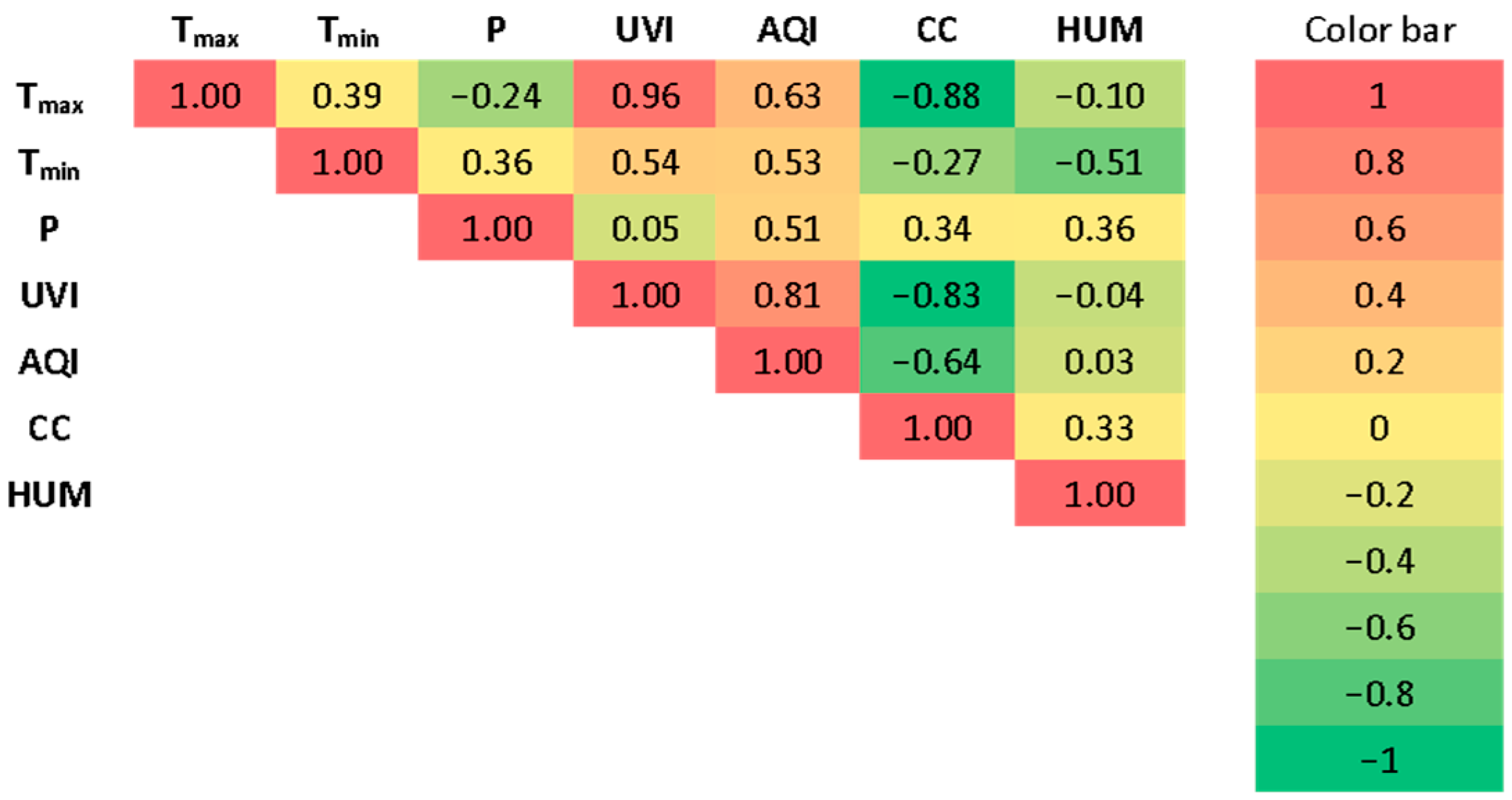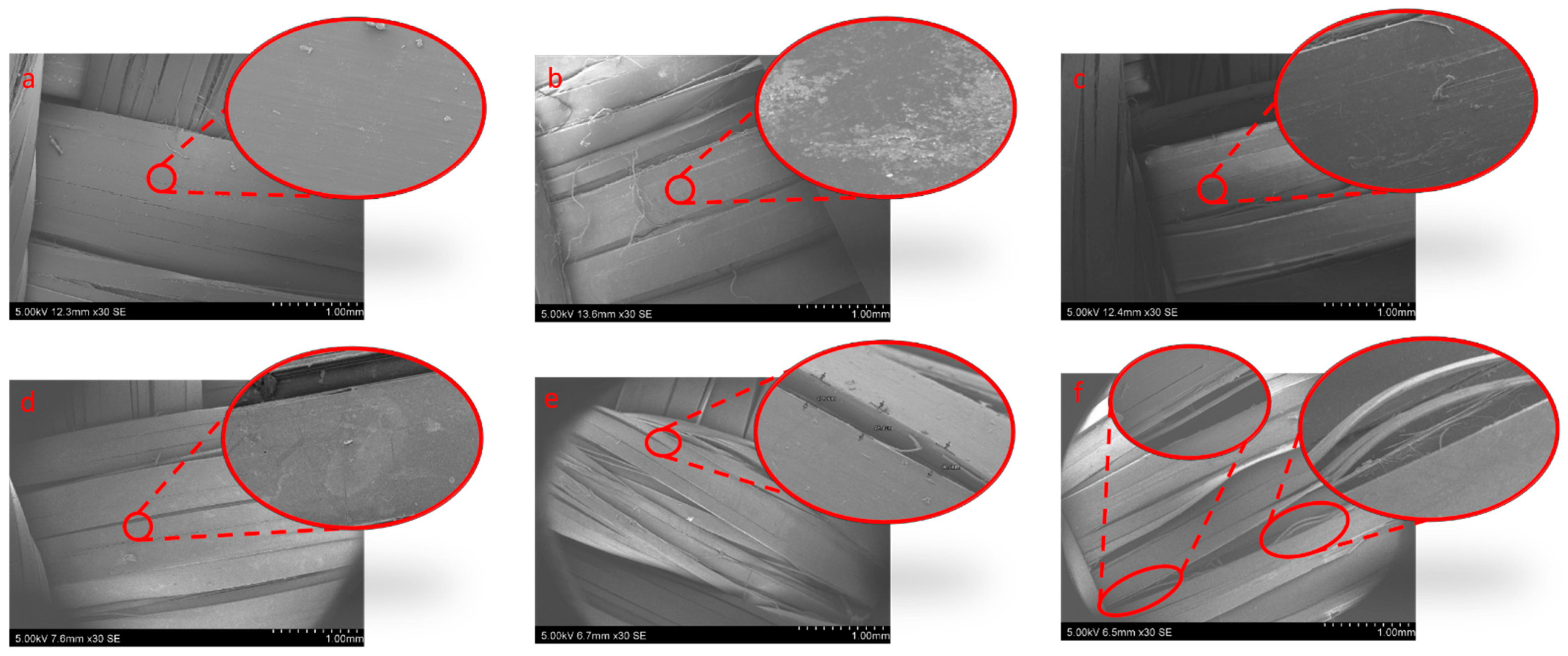Characterizing the Tensile Behaviour of Woven and Composite Fabrics under UV Exposure
Abstract
:1. Introduction
2. Materials and Methods
2.1. Engineered Fabrics
2.2. Ultraviolet Radiation
2.3. Photolysis and Photo-Oxidation Degradation
2.4. Durability of Engineered Fabrics
- Incubation of representative engineered fabrics at different temperatures, with test specimens being tensile tested on a regular basis.
- Data analysis through the extrapolation of results from high-temperature tests to lower temperatures.
- Data analysis via the conversion of laboratory half-life (time to reach 50% reduction in the initial strength) data into field-predicted durations at particular locations.
3. Experimental
3.1. Materials
3.2. Exposure Procedure
3.3. Equipment
3.3.1. Tensile Testing
3.3.2. Fourier-Transformed Infrared (FTIR) Spectroscopy
3.3.3. Scanning Electron Microscope (SEM)
4. Results and Discussions
4.1. Meteorological Data
4.2. Tensile Properties Degradation
4.3. Microstructure Analysis
4.4. Tensile Properties Degradation
5. Conclusions
Author Contributions
Funding
Institutional Review Board Statement
Informed Consent Statement
Data Availability Statement
Acknowledgments
Conflicts of Interest
References
- Carneiro, J.R.; Morais, M.; Lopes, M. Degradation of polypropylene geotextiles with different chemical stabilisations in marine environments. Constr. Build. Mater. 2018, 165, 877–886. [Google Scholar] [CrossRef]
- Kim, H.J.; Dinoy, P.R.; Kim, H.S. Tension force analysis of geotextile tubes by half cross-section test. Geotext. Geomembr. 2020, 48, 243–256. [Google Scholar] [CrossRef]
- Cantré, S.; Saathoff, F. Design method for geotextile tubes considering strain: Formulation and verification by laboratory tests using photogrammetry. Geotext. Geomembr. 2011, 29, 201–210. [Google Scholar] [CrossRef]
- Lee, S.C. Application of Geotube Breakwater for Muddy Coastline Protection in Peninsular Malaysia/Lee Siew Cheng. Ph.D. Thesis, University of Malaya, Kuala Lumpur, Malaysia, 2018. [Google Scholar]
- Nugroho, D.; Yovita Indriasari, V.; Sufyan, A.; Mahabror, D.; Rudhy, A. The application of semi-submersible geotextile tubes for coastal protection in Pamekasan, Madura. IOP Conf. Ser. Earth Environ. Sci. 2021, 860, 012100. [Google Scholar] [CrossRef]
- Rawal, A.; Shah, T.; Anand, S. Geotextiles: Production, properties and performance. Text. Prog. 2010, 42, 181–226. [Google Scholar] [CrossRef]
- Valentin, C.A.; Kobelnik, M.; Franco, Y.B.; Lavoie, F.L.; Silva, J.L.; Luz, M.P. Study of the Ultraviolet Effect and Thermal Analysis on Polypropylene Nonwoven Geotextile. Materials 2021, 14, 1080. [Google Scholar] [CrossRef]
- Rios-Soberanis, C.R.; Rodriguez-Laviada, R.; Perez-Pacheco, E. Artificial Weathering Analysis and Mechanical Behavior of Geotextiles Used for Coast Erosion Control and Beach Restoration. Adv. Mater. Res. 2015, 1101, 361–367. [Google Scholar]
- Aparicio Ardila, M.; Pedroso, G.; Kobelnik, M.; Valentin, C.; Luz, M.; Lins da Silva, J. Evaluating the Degradation of a Nonwoven Polypropylene Geotextile Exposed to Natural Weathering for 3 Years. Int. J. Geosynth. Ground Eng. 2021, 7, 1–11. [Google Scholar] [CrossRef]
- Brand, E.W.; Pang, P.L.R. Durability of Geotextiles to Outdoor Exposure in Hong Kong. J. Geotech. Eng. 1991, 117, 979–1000. [Google Scholar] [CrossRef]
- Koerner, G.R.; Hsuan, G.Y.; Koerner, R.M. Photo-Initiated Degradation of Geotextiles. J. Geotech. Geoenviron. Eng. 1998, 124, 1159–1166. [Google Scholar] [CrossRef]
- Koerner, R.M. Long-Term Geotextile Degradation Mechanisms and Exposed Lifetime Predictions. In Geotextiles; Woodhead Publishing: Sawston, UK, 2016; pp. 217–236. [Google Scholar]
- Moezzi, M.; Ghane, M.; Semnani, D. Predicting the Tensile Properties of UV Degraded Nylon66/Polyester Woven Fabric Using Regression and Artificial Neural Network Models. J. Eng. Fibers Fabr. 2015, 10, 1–11. [Google Scholar] [CrossRef]
- Yang, X.; Ding, X. Prediction of outdoor weathering performance of polypropylene filaments by accelerated weathering tests. Geotext. Geomembr. 2006, 24, 103–109. [Google Scholar] [CrossRef]
- Bhartu, V.G. Degradation of Mechanical Properties of Geotextiles and Geomembranes Exposed to Outdoor Solar Radiation under Various Exposure Condition—Part I: Results of UV-Degradation. J. Geol. Resour. Eng. 2015, 4, 173–184. [Google Scholar]
- World Health Organization (WHO); International Commission on Non-Ionizing Radiation Protection. Global Solar UV Index: A Practical Guide; WHO: Geneva, Switzerland, 1995.
- Van Dyke, S.; Titi, H.; Elhajjar, R. Comparison of California Bearing Ratio and Pin Puncture Strength Testing Used in the Evaluation of Geotextiles. Transp. Res. Rec. J. Transp. Res. Board 2017, 2656, 1–11. [Google Scholar] [CrossRef]
- Leiu, K.H.; Chin, Y.S.; Mohd Shariff, Z.; Arumugam, M.; Chan, Y.M. High body fat percentage and low consumption of dairy products were associated with vitamin D inadequacy among older women in Malaysia. PLoS ONE 2020, 15, e0228803. [Google Scholar] [CrossRef] [PubMed] [Green Version]
- Noor Ezati, S.; Muniandy, D. Sun Protection Awareness Among School Children in Malaysia. In Proceedings of the Research and Development Seminar Nuklear Malaysia 2018; Nuclear Technology Towards Sustainable Development: Kajang, Malaysia, 2019; p. 275. [Google Scholar]
- Shamey, R.; Sinha, K. A review of degradation of nylon 6. 6 as a result of exposure to environmental conditions. Rev. Prog. Color. Relat. Top. 2003, 33, 93–107. [Google Scholar] [CrossRef]
- Koo, H.; Cho, H.W.; Oh, J.T.; Zanzinger, H. A comparative study on the accelerated weathering tests for non-woven geotextiles. In Proceedings of the 10th International Conference on Geosynthetics (ICG 2014), Berlin, Germany, 21–26 September 2014. [Google Scholar]
- Suits, L.D.; Hsuan, Y.G. Assessing the photo-degradation of geosynthetics by outdoor exposure and laboratory weatherometer. Geotext. Geomembr. 2003, 21, 111–122. [Google Scholar] [CrossRef]
- Allen, S.R. 9—Geotextile durability. In Geotextiles; Koerner, R.M., Ed.; Woodhead Publishing: Sawston, UK, 2016; pp. 177–215. [Google Scholar]
- Bustillo Revuelta, M. Geosynthetics. In Construction Materials: Geology, Production and Applications; Bustillo Revuelta, M., Ed.; Springer International Publishing: Cham, Switzerland, 2021; pp. 503–537. [Google Scholar]
- ISO 13934-1; Textiles-Tensile Properties of Fabrics-Part 1: Determination of Maximum Force and Elongation at Maximum Force Using the Strip Method: Bibliographical References: Electronic Documents. ISO: Geneva, Switzerland, 2013.
- Urbaniak-Domagala, W. The Use of the Spectrometric Technique FTIR-ATR to Examine the Polymers Surface. Adv. Asp. Spectrosc. 2012, 3, 85–104. [Google Scholar] [CrossRef] [Green Version]
- Moten, S.; Yunus, F.; Ariffin, M.; Burham, N.; Jeong Yik, D.; Mat, Y.; Adam, M.; Yip, A.; Sang, W. Statistics of Northeast Monsoon Onset, Withdrawal and Cold Surges in MalaysiaStatistic of Northeast Monsoon Onset, Withdrawal and Cold Surges in Malaysia; ResearchGate GmbH: Berlin, Germany, 2018. [Google Scholar]
- Bhartu, V. Microstructural Investigation of UV-Degraded Geotextiles/Geomembranes through Scanned Electron Microscopic Study. J. Geol. Resour. Eng. 2017, 2, 61–69. [Google Scholar] [CrossRef] [Green Version]
- Fang, J.; Zhang, L.; Sutton, D.; Wang, X.; Lin, T. Needleless Melt-Electrospinning of Polypropylene Nanofibres. J. Nanomater. 2012, 2012, 382639. [Google Scholar] [CrossRef] [Green Version]
- Turmanova, S.; Genieva, S.; Vlaev, L. Obtaining Some Polymer Composites Filled with Rice Husks Ash—A Review. Int. J. Chem. 2012, 4, 62. [Google Scholar] [CrossRef] [Green Version]
- Gopanna, A.; Mandapati, R.N.; Thomas, S.P.; Rajan, K.; Chavali, M. Fourier transform infrared spectroscopy (FTIR), Raman spectroscopy and wide-angle X-ray scattering (WAXS) of polypropylene (PP)/cyclic olefin copolymer (COC) blends for qualitative and quantitative analysis. Polym. Bull. 2019, 76, 4259–4274. [Google Scholar] [CrossRef]
- Smith, B. The Infrared Spectra of Polymers III: Hydrocarbon Polymers. Spectroscopy 2021, 36, 22–25. [Google Scholar]
- Philippart, J.-L.; Sinturel, C.; Arnaud, R.; Gardette, J.-L. Influence of the exposure parameters on the mechanism of photooxidation of polypropylene. Polym. Degrad. Stab. 1999, 64, 213–225. [Google Scholar] [CrossRef]
- Wilhelm, C.; Gardette, J.-L. Infrared identification of carboxylic acids formed in polymer photooxidation. J. Appl. Polym. Sci. 1994, 51, 1411–1420. [Google Scholar] [CrossRef]









| Properties | Woven | Composite | ||
|---|---|---|---|---|
| MD | CD | MD | CD | |
| Tensile strength [kN/m] | 130 | 130 | 70 | 60 |
| Tensile strain [%] | 10 | 10 | 10 | 10 |
| UV resistance 1 (% retained) | 90 | 90 | ||
| Thickness [mm] | 1.5 | 6.3 | ||
| Mass per area [] | 535 | 1200 | ||
| Geotextiles | Months | Machine Direction | Cross-Machine Direction | ||||||
|---|---|---|---|---|---|---|---|---|---|
| [kN/m] | [%] | [%] | [%] | [kN/m] | [%] | [%] | [%] | ||
| Woven | 0 | 136.87 (±0.32) | 10.76 (±0.33) | 0.21 | 2.74 | 133.65 (±0.15) | 8.33 (±0.15) | 0.10 | 7.13 |
| 1 | 127.67 (±1.46) | 10.85 (±0.79) | 1.01 | 6.39 | 123.11 (±4.21) | 8.29 (±4.21) | 3.02 | 8.87 | |
| 2 | 124.99 (±3.20) | 9.56 (±1.28) | 2.26 | 11.83 | 122.65 (±8.90) | 7.48 (±8.90) | 6.41 | 5.51 | |
| 3 | 119.03 (±11.47) | 9.84 (±0.09) | 8.52 | 0.79 | 114.72 (±2.33) | 6.89 (±2.33) | 1.80 | 4.50 | |
| 4 | 106.65 (±6.64) | 9.82 (±0.64) | 5.50 | 5.76 | 102.98 (±2.21) | 6.70 (±2.21) | 1.89 | 4.22 | |
| 5 | 101.36 (±1.03) | 9.80 (±0.16) | 0.89 | 1.46 | 92.95 (±2.86) | 6.72 (±2.86) | 2.72 | 10.98 | |
| Composite | 0 | 60.95 (±5.04) | 8.13 (±0.91) | 7.30 | 9.94 | 52.91 (±3.49) | 6.24 (±0.11) | 5.83 | 1.52 |
| 1 | 61.76 (±0.22) | 8.37 (±0.12) | 0.32 | 1.27 | 52.84 (±0.49) | 5.92 (±0.30) | 0.82 | 4.54 | |
| 2 | 65.75 (±3.99) | 8.26 (±0.60) | 5.37 | 6.41 | 59.91 (±1.77) | 6.40 (±0.06) | 2.61 | 0.87 | |
| 3 | 65.72 (±3.32) | 8.89 (±0.95) | 4.47 | 9.44 | 64.11 (±0.89) | 6.79 (±0.13) | 1.22 | 1.71 | |
| 4 | 54.00 (±0.80) | 9.24 (±1.17) | 1.32 | 11.15 | 63.38 (±5.77) | 6.38 (±0.36) | 8.04 | 4.96 | |
| 5 | 57.41 (±0.98) | 8.19 (±0.90) | 1.51 | 9.76 | 60.16 (±1.40) | 5.15 (±0.30) | 2.06 | 5.12 | |
| Vibration | Assignment | |
|---|---|---|
| 2955, 2952, 2949 | Asymmetrical stretching | |
| 2916 | Asymmetrical stretching | |
| 2867 | Stretching | |
| 2838 | Symmetrical stretching | |
| 1456 | Symmetrical bending | |
| 1436 | Bending | |
| 1375 | Symmetrical bending | |
| 997, 972 | Rocking, stretching | , C-C |
| 840 | Rocking | C-H |
| 809 | Stretching | C-C |
Publisher’s Note: MDPI stays neutral with regard to jurisdictional claims in published maps and institutional affiliations. |
© 2022 by the authors. Licensee MDPI, Basel, Switzerland. This article is an open access article distributed under the terms and conditions of the Creative Commons Attribution (CC BY) license (https://creativecommons.org/licenses/by/4.0/).
Share and Cite
Jie, S.Y.; Hoe, L.Z.; Paul, S.C.; Anggraini, V. Characterizing the Tensile Behaviour of Woven and Composite Fabrics under UV Exposure. Appl. Sci. 2022, 12, 11440. https://doi.org/10.3390/app122211440
Jie SY, Hoe LZ, Paul SC, Anggraini V. Characterizing the Tensile Behaviour of Woven and Composite Fabrics under UV Exposure. Applied Sciences. 2022; 12(22):11440. https://doi.org/10.3390/app122211440
Chicago/Turabian StyleJie, Soon Yuan, Leow Zhi Hoe, Suvash Chandra Paul, and Vivi Anggraini. 2022. "Characterizing the Tensile Behaviour of Woven and Composite Fabrics under UV Exposure" Applied Sciences 12, no. 22: 11440. https://doi.org/10.3390/app122211440








